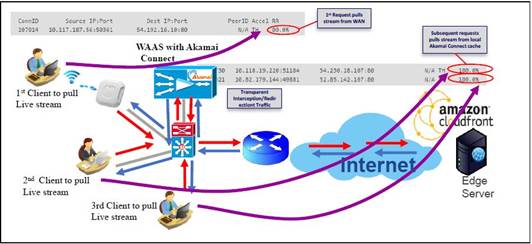Efficient Delivery of Live Video Streams
Available Languages
At Cisco, streaming video is an important tool for communicating with our global workforce. We use it to deliver live broadcasts of company events and recorded video for information and training purposes.
In 2016, we began a review of the Cisco IT video streaming infrastructure for two reasons. First, popular web browsers discontinued support for video plug-ins, which caused problems for our users and increased our support requests. Second, we wanted to improve how live video streams are delivered simultaneously to thousands of users without overloading our corporate network.
This review led Cisco IT to develop a new video streaming infrastructure based on the Cisco® Infinite Video platform and the Cisco Intelligent WAN with Akamai Connect solution. “Streaming services for consumers are on the leading edge now, so we looked at how we could adapt them to improve streaming video delivery in the enterprise,” says Ben Irving, director of infrastructure architecture, Cisco IT.
In the Cisco IT service, the Cisco Infinite Video platform receives the video stream and sends it through our cloud to distribution points around the world. From there, the Cisco Intelligent WAN with Akamai Connect solution uses Cisco Wide-Area Application Services (WAAS) to replicate the streams in local cac him and hes as needed to serve viewers.

A Better User Experience and Lower Demand on the Network
The new platform for streaming video offers several benefits for users and for Cisco IT.
Any browser, any device. Users can now access a live or recorded video stream simply by clicking a link in an email, web page, or the online program guide. The HD-quality streams appear in any web browser and no app is needed on a mobile device to watch the video or use chat and polling features.
Reduced bandwidth demand. The new infrastructure requires significantly less content replication and network bandwidth than the multicast technology we used in the past.
Scalable infrastructure. Our new infrastructure can serve up to 45,000 simultaneous users without the need for multicast or upgrades to WAN/ISP links.
Ability to reach external viewers. “In the future, we will streamline our communications to customers, suppliers, and other external viewers by using the new platform to securely distribute a video broadcast to locations outside our network,” says Wasileh Karaouni, manager, Cisco IT.
For More Information
 Feedback
Feedback